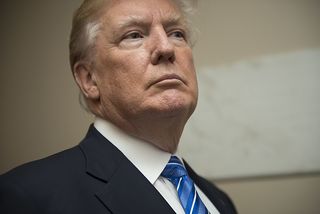President Donald Trump
Trump Divided America With Psychology — Here's How We Heal
Trump-induced existential anxiety has torn the nation apart, but it's fixable.
Posted December 27, 2017 Reviewed by Ekua Hagan
No matter who you are, or what side of the political spectrum you fall on, it is likely that President Donald Trump has significantly increased your anxiety levels, distorting your perception of the world and negatively affecting your behavior in ways you are unaware of. But the good news is that these cognitive biases and behavioral changes can be reversed if one becomes cognizant of their existence and makes a conscious effort.
The human brain is a statistical machine that must constantly be making judgments and predictions based on beliefs, feelings, and past experiences. Trump’s fear mongering and fiery rhetoric is designed to heighten emotions and alter beliefs, offsetting this fine-tuned and calibrated system. If there’s one thing that Trump understands, it’s how to benefit politically from manufacturing fear and division. He may only be following his gut instincts, but it’s strategic psychological manipulation nonetheless.
Trump provokes anxiety in both the right and the left perhaps equally, albeit in very different ways. For the right, he fuels their fears about minorities and dissimilar others, calling Hispanic immigrants “murderers and rapists,” and stating in blanket-fashion that “Islam hates us.” His demonization of the “liberal media” and the Obama administration has transformed many right-wingers into full-fledged conspiracy theorists.

For the left, President Trump is the fear. His narcissistic personality and unpredictable, unrestrained behavior makes him a dangerous commander-in-chief—one that is liable to get the U.S. into a game of nuclear chicken with countries led by similarly erratic leaders, like North Korea. Trump’s policies and willingness to please his most extreme supporters threatens the rights of gays, transgender folk, and women across the country. The only thing liberals might fear worse than Trump himself is the sentiment he brings out in his supporters, which has already proved deadly in Charlottesville, Virginia.
As a result of the amplified fear and anxiety on the right and the left, the nation is more polarized than ever, and tensions seem to be at an all-time high. So how is this heightened collective anxiety affecting us, exactly? What measurable effects does it have on our cognition and behavior?
Mortality salience increases tribalism and aggression toward out-group members.
Hundreds of studies in peer-reviewed journals have shown that when people are reminded of their mortality or exposed to a perceived existential threat — in other words, mortality is made salient, the result is a clear and predictable change in our attitudes and behavior toward others. Specifically, stimuli or events that conjure up thoughts about death cause people to cling more strongly to their cultural worldviews, increasing their support for those who share their national, ethnic, or political identity, and increasing their intolerance and aggression toward those who do not. According to Terror Management Theory, this happens because cultural worldviews — like religions, political ideologies, and national identities — help curb existential anxiety by instilling life with some form of meaning and value. Essentially, intense anxiety over a perceived threat to one’s well-being promotes tribalism, and no one is immune to it.
In fact, studies have shown that when participants are primed to think about their mortality, with something like a video or a story about death, their nationalistic bias significantly increases. We can see evidence of the psychological effects of Donald Trump’s fear mongering in the dramatic increase in nationalism and xenophobia displayed by the alt-right movement.
More evidence for this effect comes from a psychology study that found that making mortality salient increased support for extreme military interventions by American forces that could kill thousands of civilians overseas, an effect that was present only in conservatives.
By constantly emphasizing existential threat, Trump fuels the fears of Americans who will bolster their support for him in an attempt to feel safer. While this strategy keeps his supporters energized and loyal, the whole country suffers from the prejudice, aggression, and division it creates.
But the existential fear associated with Trump’s reign doesn’t just affect those on the right side of the political spectrum. Mortality salience can cause centrists and moderate liberals to shift their voting towards the right, and it can also cause liberals to be pushed further to the left. Since mortality salience fosters aggression towards those with opposing cultural worldviews, the perceived threat posed by Trump and his supporters has shifted many liberals towards more extreme positions than would be normally expected. In accordance with this concept, America has seen the rise of the militant left-wing group known as Antifa, whose tactics have progressively grown more violent towards the alt-right and neo-Nazis in a number of recent real-world confrontations.
Liberals who fear the nationalist surge the nation is witnessing become less tolerant of those they see as supporting Trump and his views towards immigrants, and more sympathetic towards the violent antics of Antifa because they are seen as well-intentioned, despite the fact that violence will ultimately be counterproductive to the liberal cause. Additionally, due to the worldview bolstering effects of existential fear and anxiety, liberals who feel threatened ideologically will tend to enforce their left-wing norms more than usual. While this might seem like a positive thing on the surface, given liberal ideals, a recent study has shown that the over-enforcement of PC norms actually serves to increase support for Donald Trump.
So, what’s the solution? How do we break the polarizing positive feedback cycle that Trump-related anxiety and fear has established? How do we reverse the division and aggression and begin to come together?
First, we must become acutely aware of the polarizing effect of Donald Trump’s presidency on both sides of the political aisle. We must openly acknowledge that the anxiety and fear created by Trump is pushing us all to our extremes, leading to tribal behavior and biases that can cloud our rational judgment.
Second, we must act in ways that alleviate these effects, and that means making a conscious effort to de-escalate confrontations and curb aggressive attitudes toward those who don’t share our worldviews or national identities. Don’t just delete those friends on social media who have opposing political opinions, no matter how much you may despise some of those beliefs. We must engage each other in rational discourse, and we must strive to see the legitimate points made by all sides, regardless of the abundance of illogical ones. And throughout this engagement process, we must stay calm and collected, as aggression only makes the division worse by increasing mortality salience. While this idea might seem futile to many liberals who have long given up on trying to talk sense into Trump supporters, we must remember that trying to heal the division is our only option. Simply letting it get worse will only lead to further chaos in America, and could contribute to another four years of this administration.
Lastly, we must not only try to build bridges when possible, we should monitor ourselves from becoming too extreme, especially when behavior towards ideologically dissimilar others becomes aggressive and violent. When that happens, the moral high ground is lost. As satisfying as it might be to watch a neo-Nazi like Richard Spencer get punched in the face, it is imperative that we remember that, in the words of Martin Luther King, Jr., “Hate begets hate; violence begets violence,” a concept that is supported by the results of Terror Management Theory and mortality salience studies.
If we all truly strive to make these efforts and resist getting discouraged by the inevitable challenges, then the nation will slowly begin to come together, and a new, stronger form of order will emerge from the current sea of chaos.




